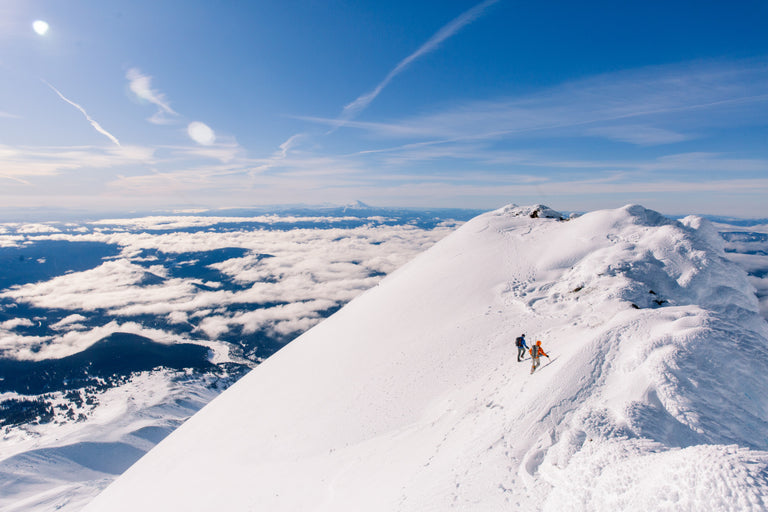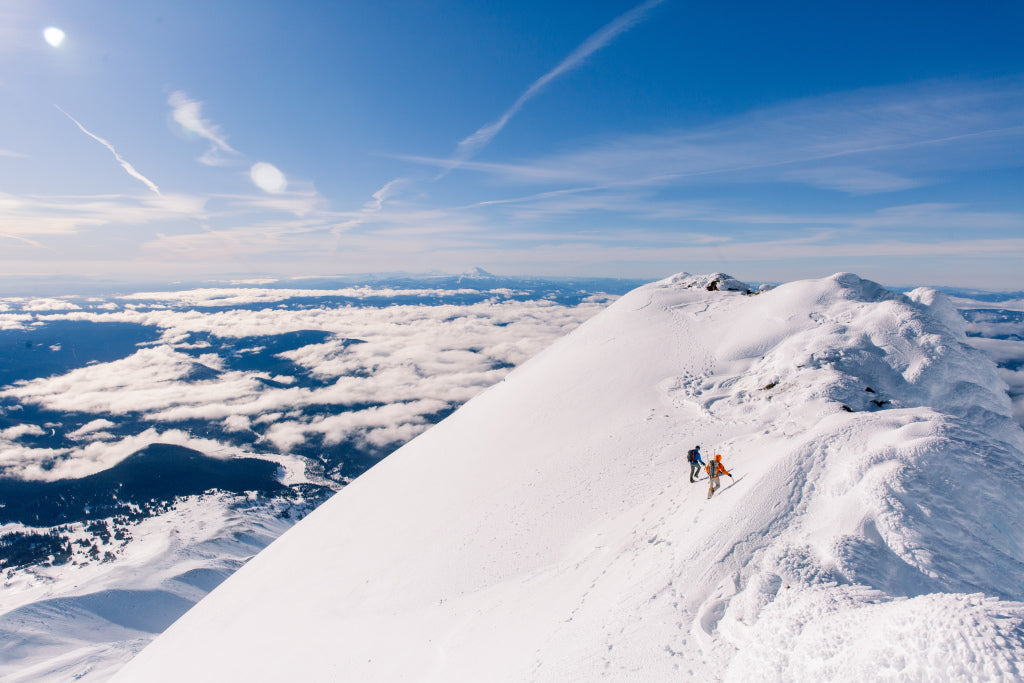Heavy breathing, high heart rate, nausea… the mountains can be unforgiving. When athletes and travelers navigate to higher altitudes, the change in air pressure has several effects on the body triggering short-term changes, called adaptations, so we can better live and play in these environments. There are several considerations if you hope to journey to these settings; if pushed under the rug can lead to serious health issues. As more and more people travel to higher altitudes, it is important to understand what happens to the body, how we can use it to our advantage, and what steps we can take to combat these changes.
The Environment
Whether you go into the mountains or to the sea floor, changes in pressure impact the oxygen concentration in your body. Contrary to popular belief, the percent of oxygen in the air stays the same within all of earth's atmosphere, regardless of increasing altitude. There is 21 percent oxygen in the earth’s atmosphere. As you ascend to a higher altitude, the 21 percent comes from a smaller amount due to changes in atmospheric pressure (17). Barometric pressure is a measurement of air pressure that goes down as you move higher and up as you move lower (6, 14). The decrease in air pressure causes oxygen molecules to be further apart, which provides less of a driving force for oxygen to move from outside to inside our lungs. Oxygen saturation refers to how much oxygen is bound to red blood cells, which is how it travels throughout the body. Due to the reduction in air pressure in these settings, the volume you take into your lungs contains fewer oxygen molecules per breath, triggering compensatory responses like heavy breathing, elevated heart rate, dizziness, etc. The change in pressure and how much oxygen is circulating immediately tells our body to make protective improvements to minimize its harmful effects.

Body Changes
Our bodies are efficient at adjusting to new settings extremely fast. Adaptation refers to the body moving back to a balanced state to benefit us, known as homeostasis (9). When exposures are repeated, the changes occurring in your body are also referred to as acclimatization (1).
Within minutes of ascending to a new altitude, our breathing and heart rate increase to attempt to compensate for the change in atmospheric pressure. This is the body attempting to move more oxygen to fuel muscles and organs. Your body moves into a hypoxic state, meaning there is a deficiency in the amount of oxygen traveling to body tissues. Hypoxia signals the kidneys to produce a protein called erythropoietin, cascading a bodily response to create more red blood cells. Red blood cells move oxygen within the freeway network of the body, the cardiovascular system. Greater red blood cells allow us to move oxygen more easily (6, 11).
Over several hours at a higher altitude, you begin to lose fluids and risk dehydration. Changes in hydration status are due to sweating, burning calories, and an increased breathing rate (15). Increases in metabolism as you ascend to higher altitudes increase the number of calories burned at rest. Even though more fuel is necessary to sustain your body's needs, you’re likely to be less hungry in these settings; dehydration plays a large role in this. Changes in metabolism and appetite make neutral energy balance essential by consuming more calories than usual (7). Athletes should consider how much iron they get from their diet, as it is required for red blood cell production (16). There is also disrupted sleep within these environments. The blood's low oxygen saturation affects the brain's sleep center. Sleeping at an unacclimated altitude is associated with decreased total sleep time. There is also a shift from deep to light sleep (10, 21).
Over several days or weeks, your body will adjust to the new altitude. The primary driver of long-term acclimation is the changes to the cardiovascular system, mainly the production of new red blood cells. This addition and our body establishing more blood vessels within our muscles improve our oxygen delivery methods (11). The adaptations that occur due to the acclimatization process stick with you over time. Once you return to a lower altitude, your body begins to shift back to its original state. People who live at higher altitudes have a higher capacity for these environments. High-mountain natives and sherpas have been shown to have larger lung volumes, making them more efficient at transporting oxygen. Generations of families who live in these settings even pass on adaptations to their kids; such beneficial cardiovascular characteristics are seen in newborns, too (8).
There are risks in these environments. If you go to a new altitude too fast, it can make you sick. Although our body is highly efficient at modifying for new environments, slow and steady are key. You may have heard of altitude or mountain sickness; medically, it’s referred to as Acute Altitude Sickness (AAS). The symptoms of AAS are similar to a hangover. If you experience a headache, excessive fatigue, loss of appetite, nausea, or vomiting, it’s time to slow down or return to a lower altitude. Moving to a lower altitude typically relieves symptoms. You can risk more serious sickness or death if you ignore these symptoms. High Altitude Pulmonary Edema (HAPE) and High Altitude Cerebral Edema (HACE) are serious illnesses and can be deadly within 24 hours. If your AAS symptoms do not improve and you begin to feel weakness, cough, confusion, or trouble walking, it’s time to get supplemental oxygen and descend to a lower altitude. Knowing these symptoms and what to do can save your life (19, 22).

Impact and Application to Sports
Despite these rapid adaptations, these environments initially make physical activity more challenging. The greater challenge is that less circulating oxygen is accessible for working muscles, organs, and our brains. Any aerobic event (activity longer than two minutes) or exercise at a new altitude will be more challenging than at lower altitudes. This change impacts the intensity and pace you can sustain exercise (8). Taking breaks and rest stops at new elevations is essential to avoid exhaustion and illness. Due to changes in metabolism and hydration status, athletes need more water and fuel before and during activities (7). It is important to remember that although lower oxygen availability changes how we engage in our sports, being under-fueled and under-hydrated makes the lowered performance even more prominent. Like any activity or event, preparation is key!
Athletes have several options to reduce the impact of hypoxia on their sports performance and take altitude-stimulated adaptations (e.g., more red blood cells) back to low-land with them. If possible, give yourself time to adjust to a new altitude. If you have an event, planning to arrive even a few days early can give your body time to begin adjusting. Adaptations can be made at rest and while sleeping, too - Just being their places yourself in a good spot to prepare. Most athletes perform at moderate increases in altitude, near 7,000 to 9,000 feet above sea level, or higher than where they live. For example, if an athlete were to travel from Miami, Florida (about 7 feet above sea level) to Park City, Utah (about 7,000 feet above sea level) for a trail race, they can anticipate it taking about two to three weeks to fully acclimate to this new environment; with adaptations improving athletic performance linearly to match what they can do at baseline (2, 3). Trips to very high- (11,500 to 18,000 feet above sea level) or extremely high altitudes (above 18,000 feet above sea level) should be made progressively, called “stages” (3, 5). Athletes who stage their progression, regardless of the end location’s altitude, improve their performance greater (nearly 44 percent greater) compared to those who don’t stage (4).
Short trips to higher altitudes, even just 1,000 feet higher than what you are accustomed to, encourage your body to become conditioned to handle the low-pressure stress of these areas (2). Our bodies are great at adapting to training stress that mirrors our larger objective, so practice moving uphill, improving your aerobic capacity, and ability to recover fast will prepare us for the demands of these settings. Improving your ability to sustain higher intensity work is a great way to improve heart performance. Overall, having a stronger heart and lungs will reduce the perceived impact of lower atmospheric pressure.
Some athletes even sleep, vacation, and train at high altitudes for events in lower settings. The adaptations triggered when living at or visiting these settings, like enhanced oxygen carrying capacity, positively impact performance at lower altitudes (16, 20). Unfortunately, the effects of high-altitude exposure are time-bound. As mentioned above, our bodies are extremely efficient; we get rid of what we don’t need in several days. Living at a higher altitude doesn't make an athlete immune to this. The big takeaway is when we place stress, especially appropriate levels of repeated stress, our body develops a degree of stress resistance for the next time, hopefully promoting a lower risk of dehydration and illness.
Like any form of training, the additional stress placed on the body in these settings, whether visiting or training, should not be forgotten. It’s essential to manage training volume and consider training intensity in these settings to place a larger burden on the body. Give yourself enough time to recover between sessions (16). Too much training, especially without sufficient recovery, can reduce performance and place an athlete at risk of injury in any environment. Athletes should also consider planning their hydration and fuel routine before, during, and after training in these settings. Ensuring electrolyte balance (sodium, potassium, calcium, and magnesium) and iron intake is accounted for in the days leading up to and during activities to feel good and perform your best while preparing for your next high-altitude adventure or competition (16, 18).

How to Prevent and Prepare
It is essential to understand what occurs to our bodies within these environments. This understanding can even save your life! With all of this in mind, here are ways to prepare for these bodily changes and make them less impactful on your next high-altitude journey:
- Engage in more physical activity leading up to your trip, specifically aerobic exercise (the higher the intensity, the better).
- Hydrate for at least three days before your trip and ensure you consume enough electrolytes (sodium, potassium, calcium, and magnesium).
- Create a plan to consume more calories for energy balance, considering the amount of iron.
- Plan for time to adjust to new settings, and if possible, “stage” your progression to the new altitude (night one at 1,000 feet, night two at 2,000 feet, and night three at 3,000 feet).
- Sleep disruptions are common when adjusting, give yourself extra time to rest.
- Learn and communicate with your travel partners about the signs and symptoms of high-altitude illness and plan for an event.

References:
-
Armstrong, A.F. and Dudgeon, P. (1988), A systemic approach to occupational stress. Syst. Res., 5: 101-106. https://doi.org/10.1002/sres.3850050204
-
Burtscher, M., Millet, G. P., & Burtscher, J. (2022). Hypoxia Conditioning for High-Altitude Pre-acclimatization. Journal of Science in Sport and Exercise. doi:10.1007/s42978-021-00150-0
-
Burtscher, M., Niedermeier, M., Burtscher, J., Pesta, D., Suchy, J., & Strasser, B. (2018). Preparation for Endurance Competitions at Altitude: Physiological, Psychological, Dietary and Coaching Aspects. A Narrative Review. Frontiers in physiology, 9, 1504. https://doi.org/10.3389/fphys.2018.01504
-
Fulco, C. S., Muza, S. R., Beidleman, B., Jones, J., Staab, J., Rock, P. B., et al. (2009). Exercise performance of sea-level residents at 4300 m after 6 days at 2200 m. Aviat. Space Environ. Med. 80, 955–961. doi: 10.3357/ASEM.2540.2009
-
Gallagher, S. A., & Hackett, P. H. (2004). High-altitude illness. Emergency medicine clinics of North America, 22(2), 329–viii. https://doi.org/10.1016/j.emc.2004.02.001
-
Hackett, P. H., & Roach, R. C. (2001). High-altitude illness. The New England journal of medicine, 345(2), 107–114. https://doi.org/10.1056/NEJM200107123450206
-
Lippl, F. J., Neubauer, S., Schipfer, S., Lichter, N., Tufman, A., Otto, B., & Fischer, R. (2010). Hypobaric hypoxia causes body weight reduction in obese subjects. Obesity (Silver Spring, Md.), 18(4), 675–681. https://doi.org/10.1038/oby.2009.509
-
McClelland, G. B., & Scott, G. R. (2019). Evolved Mechanisms of Aerobic Performance and Hypoxia Resistance in High-Altitude Natives. Annual review of physiology, 81, 561–583. https://doi.org/10.1146/annurev-physiol-021317-121527
-
Moore L. G. (2017). Measuring high-altitude adaptation. Journal of applied physiology (Bethesda, Md. : 1985), 123(5), 1371–1385. https://doi.org/10.1152/japplphysiol.00321.2017
-
Nussbaumer-Ochsner, Y., Ursprung, J., Siebenmann, C., Maggiorini, M., & Bloch, K. E. (2012). Effect of short-term acclimatization to high altitude on sleep and nocturnal breathing. Sleep, 35(3), 419–423. https://doi.org/10.5665/sleep.1708
-
Paralikar, S. J., & Paralikar, J. H. (2010). High-altitude medicine. Indian journal of occupational and environmental medicine, 14(1), 6–12. https://doi.org/10.4103/0019-5278.64608
-
Périard, J. D., Racinais, S., & Sawka, M. N. (2015). Adaptations and mechanisms of human heat acclimation: Applications for competitive athletes and sports. Scandinavian journal of medicine & science in sports, 25 Suppl 1, 20–38. https://doi.org/10.1111/sms.12408
-
Périard, J. D., Travers, G., Racinais, S., & Sawka, M. N. (2016). Cardiovascular adaptations supporting human exercise-heat acclimation. Autonomic neuroscience : basic & clinical, 196, 52–62. https://doi.org/10.1016/j.autneu.2016.02.002
-
Richalet J. P. (2020). CrossTalk opposing view: Barometric pressure, independent of PO2 , is not the forgotten parameter in altitude physiology and mountain medicine. The Journal of physiology, 598(5), 897–899. https://doi.org/10.1113/JP279160
-
Richardson, A., Watt, P., & Maxwell, N. (2009). Hydration and the physiological responses to acute normobaric hypoxia. Wilderness & environmental medicine, 20(3), 212–220. https://doi.org/10.1580/09-WEME-OR-272R1.1
-
Saunders, P. U., Garvican-Lewis, L. A., Chapman, R. F., & Périard, J. D. (2019). Special Environments: Altitude and Heat. International journal of sport nutrition and exercise metabolism, 29(2), 210–219. https://doi.org/10.1123/ijsnem.2018-0256
-
Sharp, T. (2017). Earth's Atmosphere: Composition, Climate & Weather. Space. Main.
-
Tambalis, Konstantinos. (2022). THE EFFECT OF ELECTROLYTES AND ENERGY DRINKS CONSUMPTION ON ATHLETIC PERFORMANCE - A NARRATIVE REVIEW. 3. 1-25. 10.46827/ejfnsm.v3i1.127.
-
Taylor A. T. (2011). High-altitude illnesses: physiology, risk factors, prevention, and treatment. Rambam Maimonides medical journal, 2(1), e0022. https://doi.org/10.5041/RMMJ.10022
-
Vogt, M., & Hoppeler, H. (2010). Is hypoxia training good for muscles and exercise performance?. Progress in cardiovascular diseases, 52(6), 525–533. https://doi.org/10.1016/j.pcad.2010.02.013
-
Weil J. V. (2004). Sleep at high altitude. High altitude medicine & biology, 5(2), 180–189. https://doi.org/10.1089/1527029041352162
-
West, J. B., Schoene, R. B., Luks, A. M., & Milledge, J. S. (2012). High Altitude Medicine and Physiology (5th ed.). Boca Raton, FL: CRC Press. https://doi.org/10.1201/b13633






